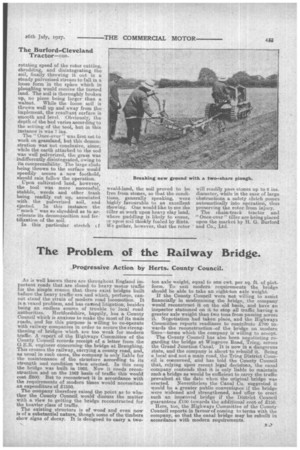The Problem of the Railway Bridge.
Page 9

If you've noticed an error in this article please click here to report it so we can fix it.
\Progressive Action by Herts. County Council.
As is well known there are throughout England important roads that are closed to heavy motor traffic for the simple reason that there exist bridges built ;before the heavy traffic era and which, perforce. cannot stand the strain of modern road locomotion. It is a vexed problem, and has caused litigation, besides being an endless source of trouble to local road authorities. Hertfordshire, happily, has a County Council which is anxious to make the most of its main roads, and for this purpose is willing to co-operate with railway companies in order to secure the strengthening of bridges which are too weak for modern traffic. A report of the Highways Committee of the County Council records receipt of a letter from the G.E.R. engineer concerning the bridge at Braughing. This crosses the railway, carrying a county road, and, as usual in such cases, the company is only liable for the maintenance of the structure according to its strength and condition when erected. In this case the bridge was built in 1882. Now it needs reconstruction and on the 1862 basis of traffic this would cost £600. But to reconstruct it in accordance with the requirements of modern times would necessitate an expenditure of 21550.
The company therefore raised the point as to whether the County Council would discuss the matter with a view to getting the bridge reconstructed for the heavier class of traffic.
The existing structure is of wood and even now is of a substantial nature, though some of the timbers show signs of decay. It is designed to carry a two ton axle weight, equal to one cwt. per sq. ft. of platform. To suit modern requirements the bridge should be able to take an eight-ton axle weight.
If the County Council were not willing to assist financially in modernizing the bridge, the company would reconstruct it on the old basis, and have an inspector stationed on it to stop all traffic having a greater axle weight than two tons from passing across ia Negotiation had taken place, and the Highways Committee reports readiness to contribute £700 towards the reconstruction of the bridge on modern Tines—terms which the company is willing to accept.
The County Council has also been negotiating regarding the bridge at Wingrove Road, Tring,, across the Grand Junction Canal. It is now in a dangerous state, and the company is about to rebuild it. Being a local and not a main road, the Tring District Council is aoncerned, and has told the County Council that, relying upon recent legal decisions, the canal company contends that it is only liable to maintain such a bridge as would be sufficient to carry the traffic prevalent at the date when the original bridge was erected. Nevertheless the Canal Co. suggested it would be a greater public convenie,nce if the bridge were widened and strengthened, and offer to erect such an improved bridge if the District Council guarantees 2100 towards the additional cost of £150. Here, too, the Highways Committee of the County Council reports in favour of coming to terms with the company, so that the canal bridge may be rebuilt in accordance with modern requirements.




















